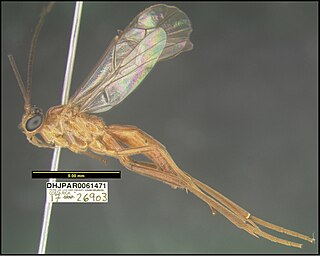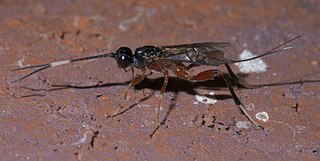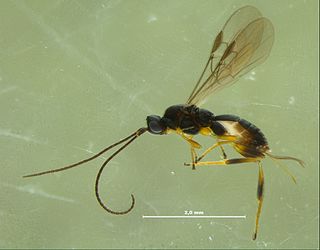
The Braconidae are a family of parasitoid wasps. After the closely related Ichneumonidae, braconids make up the second-largest family in the order Hymenoptera, with about 17,000 recognized species and many thousands more undescribed. One analysis estimated a total between 30,000 and 50,000, and another provided a narrower estimate between 42,000 and 43,000 species.

The Cheloninae are a cosmopolitan subfamily of braconid parasitoid wasps.

Agathidinae is a subfamily of braconid parasitoid wasps. Some species have been used in biological control programs.

The Doryctinae or doryctine wasps are a large subfamily of parasitoid wasps within the family Braconidae.

The Euphorinae are a large subfamily of Braconidae parasitoid wasps. Some species have been used for biological pest control. They are sister group to the Meteorinae.

Cystomastacoides is a genus of parasitoid wasps belonging to the family Braconidae. It was named by Dutch entomologist Kees van Achterberg in 1997 from a single species Cystomastacoides coxalis discovered in Yunnan, China. There are only four species described in the genus, the other three having been reported on 19 March 2013. As typical ichneumon wasps, they are characterised by a deadly parasitoid behaviour. Their larvae grow inside the body of other insects, such as caterpillars, and feed on their internal organs inside the body until they emerge.

Dinotrema is a genus of wasps in the family Braconidae. Species are amongst the largest parasitoid wasps in the tribe Alysiini (Alysiinae). There are approximately 350 species described around worldwide.

The Cenocoeliinae are a subfamily of braconid parasitoid wasps.

The Homolobinae are a subfamily of braconid parasitoid wasps.
Dirrhope is the only extant genus in the subfamily Dirrhopinae of braconid parasitoid wasps. Dirrope was included in the Microgastrinae until 1984. Specimens of this genus have been found fossilsed in amber dating from the Cretaceous period.

Brachistinae is a subfamily of braconid wasps in the family Braconidae.

Helconinae is a subfamily of braconid wasps in the family Braconidae.

Colastes is a genus of braconid wasps in the family Braconidae. There are at least 80 described species in Colastes.
The Acampsohelconinae are a subfamily of braconid parasitoid wasps. Extant members of this subfamily were previously included in the Helconinae, Blacinae, or Sigalphinae. The four genera included are †Acampsohelcon, Afrocampsis, Canalicephalus, and Urosigalphus.

Orgilus is a genus of insects belonging to the family Braconidae.
Aleiodini is a tribe of parasitoid wasp in the family Braconidae. It is represented in the whole world. It is the sister tribe to Yeliconini and Facitorini.
Betylobraconini is a tribe of parasitoid wasp in the family Braconidae. It is represented across Australasia. It is the sister tribe to Gondwanocentrini.
Clinocentrini is a tribe of parasitoid wasp in the family Braconidae. It is represented in the whole world. It is sister to Betylobraconini + Gondwanocentrini.















